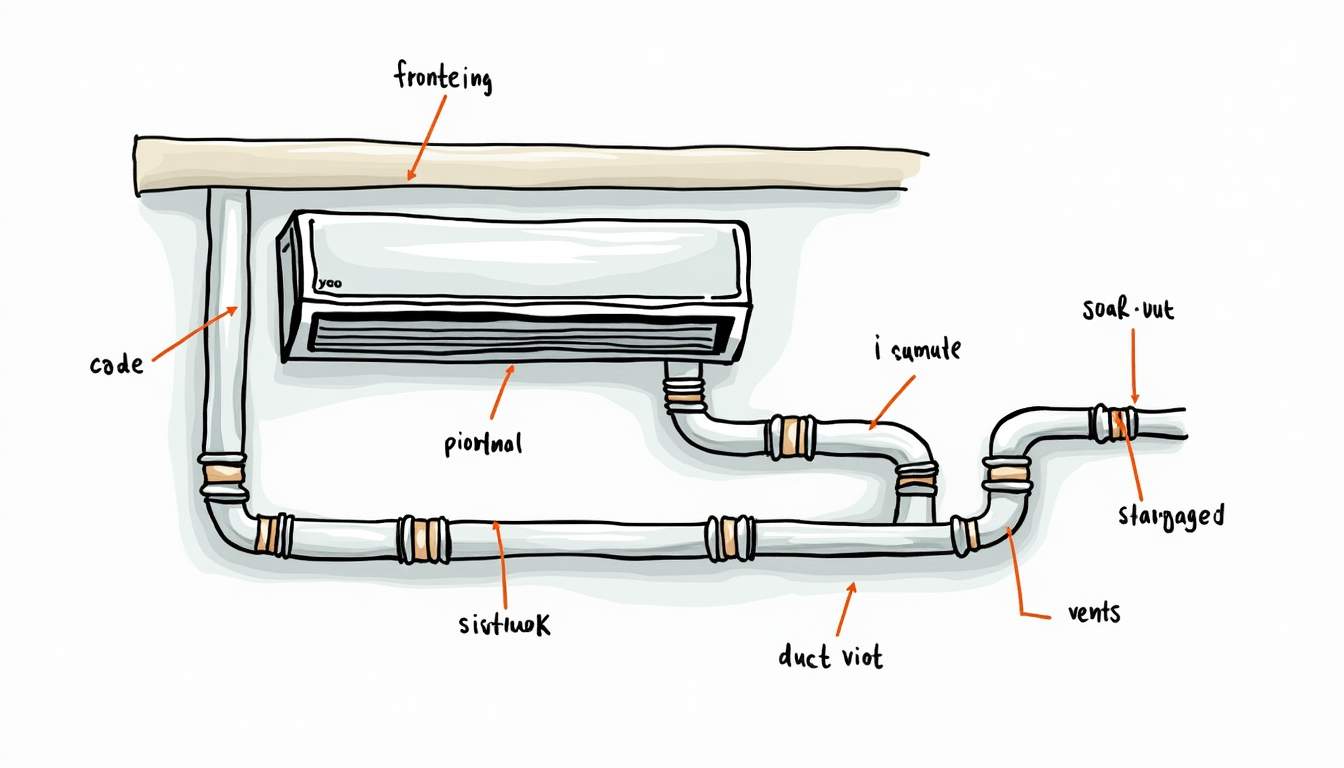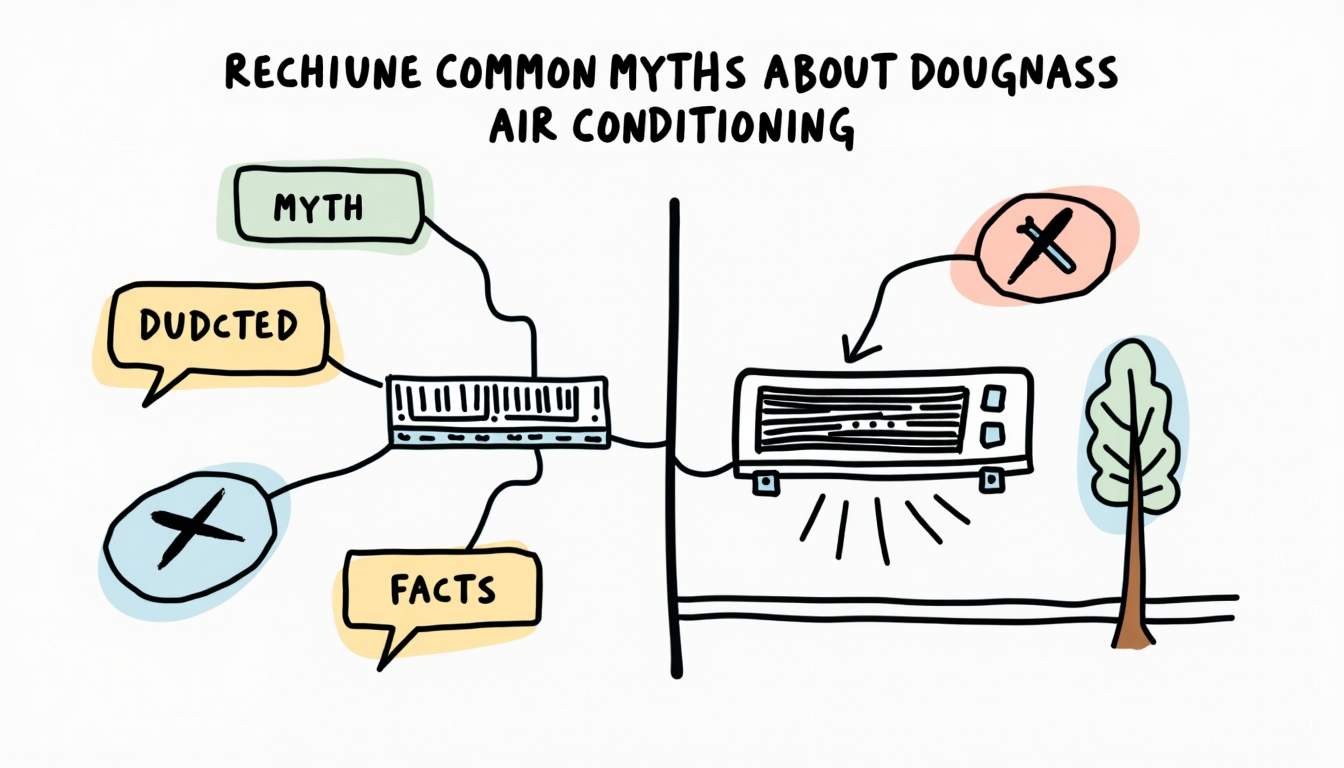Imagine walking into a home where the temperature is perfectly balanced, no matter the weather outside. The air feels fresh, cool in summer, warm in winter, and you don’t see a single bulky unit spoiling the décor. This is the magic of ducted air-conditioning systems. They quietly work behind the scenes, delivering comfort throughout the entire home or office without the clutter of multiple wall units.
What Is a Ducted Air-Conditioning System?
Ducted air-conditioning is a centralized system that uses a network of ducts to distribute conditioned air—either cooled or heated—throughout a building. Unlike split systems that have individual units in each room, ducted systems rely on one main unit connected to a series of ducts hidden in ceilings or under floors. This design not only provides a cleaner aesthetic but also maximizes the use of space, allowing for more versatile interior design options without the clutter of multiple units.

The main components include the air handler (which houses the evaporator coil), the compressor unit (usually placed outside), and the ductwork that channels air to different rooms via vents or grilles. This setup allows for consistent and uniform temperature control across multiple spaces. Additionally, ducted systems can be integrated with air filtration systems, enhancing indoor air quality by removing dust, allergens, and other pollutants from the air before it circulates through the home.
How Does It Work?
The system draws air from the rooms through return air vents, conditions it by cooling or heating, and then pushes the treated air back through supply vents. Thermostats control the temperature, and zoning options allow different rooms or areas to be cooled or heated independently. This means you can keep the living room cool during the day while maintaining a warmer temperature in bedrooms, saving energy and enhancing comfort. Moreover, the ability to customize temperatures in various zones can lead to significant energy savings, as you can avoid heating or cooling unoccupied spaces.
In addition to energy efficiency, ducted air-conditioning systems can also be equipped with smart technology, allowing homeowners to control their climate settings remotely through smartphone apps. This feature not only adds convenience but also enables users to monitor and adjust their energy consumption in real-time, further optimizing their energy usage. Furthermore, many modern systems are designed to operate quietly, ensuring that the comfort of your home is not disrupted by noisy machinery, making them an ideal choice for both residential and commercial applications.
Advantages of Ducted Air-Conditioning Systems
Whole-Home Comfort
One of the biggest draws of ducted systems is their ability to provide even temperature control throughout the entire property. No more battling hot and cold spots or dragging portable units from room to room.
Because the system is centralized, it can efficiently cool or heat large spaces, making it ideal for bigger homes or commercial buildings. This uniformity in temperature not only enhances comfort but also contributes to a more productive environment, particularly in workplaces where concentration and comfort are paramount. With the ability to set different temperatures in various zones, families can enjoy personalized comfort tailored to individual preferences, ensuring that everyone feels at ease in their own space. For reliable cooling solutions, visit SoCool for expert services.
Discreet and Aesthetically Pleasing
Since the ductwork is hidden within ceilings or floors and only small vents are visible, the system maintains a clean and uncluttered look. This is a huge plus for homeowners who want effective climate control without sacrificing interior design.
Moreover, the unobtrusive nature of ducted systems allows for greater flexibility in interior design choices. Homeowners can freely arrange furniture and decor without the hindrance of bulky air conditioning units or visible ductwork. This seamless integration into the home’s architecture not only preserves the aesthetic appeal but also enhances the overall value of the property, making it a wise investment for future resale.
Energy Efficiency and Cost Savings
When properly installed and maintained, ducted systems can be highly energy-efficient. Zoning capabilities mean you only condition the spaces you’re using, reducing wasted energy. Modern systems often incorporate inverter technology, which adjusts compressor speed to match cooling or heating demand, further improving efficiency.
While the upfront cost can be higher than other systems, the long-term savings on energy bills and increased property value often justify the investment. Additionally, many ducted systems are designed to operate quietly, contributing to a more peaceful home environment. This combination of efficiency and tranquility makes ducted air conditioning an attractive choice for those looking to enhance their living spaces without the disruptive noise often associated with traditional units.
Improved Air Quality
Ducted systems often come with advanced filtration options that help remove dust, allergens, and pollutants from the air. This is especially beneficial for people with allergies or respiratory conditions.
Regular maintenance of the ducts and filters ensures the air circulating in your home stays clean and fresh. In fact, some systems offer additional features such as UV light technology, which can further purify the air by eliminating bacteria and viruses. This is particularly advantageous for families with young children or elderly members, as it creates a healthier living environment. Furthermore, the ability to control humidity levels through a ducted system can also prevent the growth of mold and mildew, contributing to overall better health and comfort within the home.
Potential Drawbacks to Consider
Installation Complexity and Cost
Installing ducted air-conditioning requires significant planning and professional expertise. The ductwork needs to be carefully designed and fitted within the structure, which can be disruptive and costly, especially in existing buildings without pre-installed ducts.

Compared to split systems, the initial installation expense is higher, and retrofitting can be challenging.
Maintenance Requirements
Because the system relies on a network of ducts, regular cleaning and inspection are essential to maintain performance and air quality. Dust and debris can accumulate inside ducts, reducing efficiency and potentially causing health issues.
Filters need to be changed or cleaned periodically, and professional servicing is recommended to keep the system running smoothly.
Limited Flexibility in Some Cases
Once installed, ducted systems are relatively fixed. Moving vents or adding new zones can be complicated and expensive. This contrasts with split systems, which can be added or relocated more easily.
Types of Ducted Air-Conditioning Systems
Single Split Systems
These systems consist of one outdoor compressor connected to one indoor air handler that supplies air through ducts. They are suitable for smaller homes or offices with limited zones.
Multi-Split Systems
Multi-split setups use one outdoor unit connected to multiple indoor air handlers or zones. This allows for more precise control over different areas but can be more complex and costly.
Reverse Cycle Systems
Reverse cycle ducted air-conditioning provides both heating and cooling by reversing the refrigeration cycle. This makes it a year-round solution, eliminating the need for separate heating systems.
Choosing the Right Ducted System for Your Space
Assessing Your Needs
Start by considering the size of your property and the number of rooms you want to condition. Larger homes with multiple rooms benefit most from ducted systems, especially if you want a uniform temperature throughout.
Think about your lifestyle too. If you spend most of your time in certain areas, zoning can help save energy by conditioning only those spaces.
Professional Design and Installation
Consulting with an experienced HVAC professional is crucial. They will assess your building’s layout, insulation, and airflow requirements to design a system that meets your needs efficiently.
Proper installation affects performance, energy efficiency, and longevity. Cutting corners can lead to poor airflow, uneven temperatures, and higher running costs.
Energy Ratings and Features
Look for systems with high energy efficiency ratings, such as those certified by ENERGY STAR or similar programs. Features like inverter compressors, smart thermostats, and programmable timers enhance control and reduce energy consumption.
Maintaining Your Ducted Air-Conditioning System
Regular Filter Cleaning and Replacement
Filters trap dust and airborne particles, so keeping them clean is essential. Depending on the system, filters may need cleaning or replacement every 1 to 3 months.
Duct Cleaning
Over time, dust and debris build up inside ducts, impacting air quality and system efficiency. Professional duct cleaning every few years can prevent these issues.
Annual Professional Servicing
Scheduling yearly maintenance with a qualified technician ensures all components, including the compressor, fan, and thermostat, are functioning correctly. This helps catch minor problems before they become costly repairs.
Common Myths About Ducted Air-Conditioning
“Ducted Systems Are Too Expensive”
While the initial cost is higher than some alternatives, the long-term benefits often outweigh this. Energy savings, increased home value, and superior comfort make ducted systems a smart investment for many.

“They Are Noisy”
Modern ducted systems are designed to operate quietly. The noisy components are typically located outside or in concealed areas, so inside the home, you usually hear only a gentle airflow.
“Ducts Cause Poor Air Quality”
When properly maintained, ducted systems can improve indoor air quality. Neglecting maintenance, however, can lead to dust buildup, which is why regular cleaning is critical.
Is a Ducted System Right for You?
If you value whole-home comfort, a neat aesthetic, and efficient climate control, ducted air-conditioning is worth considering. It’s particularly suitable for new builds or major renovations where ductwork can be integrated seamlessly.
For smaller spaces or those on a tight budget, split systems might be more practical. But for larger homes and commercial spaces, the benefits of ducted systems often justify the investment.
Ultimately, the best choice depends on your specific needs, budget, and building layout. Consulting with HVAC professionals can help you make an informed decision tailored to your situation.
Final Thoughts
Ducted air-conditioning systems offer a blend of efficiency, comfort, and style that’s hard to beat. They provide consistent temperature control across multiple rooms without the visual clutter of wall-mounted units.
Though installation and maintenance require some commitment, the payoff is a comfortable, energy-efficient environment that enhances your living or working space. Understanding how these systems work and what to expect can help you choose the best solution for your home or business.
 WhatsApp Us Now
WhatsApp Us Now
